
Chip Somodevilla / Staff / Getty Images
In the world of science, debates rarely end. Only after years of careful analyses, rigorous scientific studies, and the replication of findings can scientists safely declare they believe a theory has likely been proven. And even then, real scientists know virtually every scientific conclusion is subject to further debate and experimentation as additional insights are discovered.
On the topic of the science of climate change, including the causes and potential dangers, the debate is still very much alive and well. But the current climate-change debate held in most public forums, including in Washington, D.C., has never been particularly scientific (that is, adhering to the scientific method), and after three decades of debating the claims made repeatedly by climate alarmists such as Al Gore, it’s clear the debate is over, and the alarmists have lost.
What alarmists believe
The current climate alarmist debate involves only two groups. The alarmists are those who say climate change is happening, that it is now and has for decades been caused by humans’ greenhouse-gas emissions, that the warming is causing or will soon cause catastrophic problems, and, most importantly, that the evidence is overwhelming and beyond dispute. Anyone who doesn’t believe in all four of those assertions falls, whether they realize it or not, into the “climate skeptic” camp, a rather large tent.
If this description of the debate surprises you, it’s only because for 30 years alarmists have consistently and improperly been claiming climate-change skeptics are “deniers” — a name that was deliberately chosen because of its link to Holocaust “deniers” — who are stupid, corrupt, or both. They’ve spread countless falsehoods about what global warming actually is and have repeatedly made untrue claims about what skeptics believe.
Is the science settled?
One thing is abundantly clear, however: For alarmists, anyone who doesn’t accept the climate-change dogma, which, again, includes all four of the claims made above, is dangerous.
“This is scary stuff, above and beyond everything else that scares us about Republicans,” Sen. Bernie Sanders (I-Vt.) said in 2016. “You have a major political party which has turned its back on science regarding climate change. … It is caused by human activity. And it is already, not tomorrow but today, causing massive problems all over this country.”
So certain are the climate alarmists of their position that many of them have suggested it could be appropriate to imprison climate-change skeptics. Pop-culture “scientist” Bill Nye suggested as much in an April 2016 interview.
“Was it appropriate to jail the guys from Enron?” Nye said. “We’ll see what happens. … In these cases, for me, as a taxpayer and voter, the introduction of this extreme doubt about climate change is affecting my quality of life as a public citizen. So, I can see where people are very concerned about this, and they’re pursuing criminal investigations as well as engaging in discussions like this.”
The climate-alarmism debate is clear, so the only question is: Are the alarmists right? On this point, the facts are apparent: Although there is still a debate over whether the climate is still warming significantly, what the causes for the warming are, and whether warming will cause more harm than good, it is now certain that the evidence is not anywhere near overwhelming enough for Gore, Sanders, and Nye to make their most important claim: that the debate is over and that the theory of human-caused climate change has unquestionably been resolved in climate alarmists’ favor.
The evidence: climate models
Let’s start with the basics. If climate alarmists are correct that the debate is over, why can’t they prove it using scientific data? Because the climate is incredibly complex, climate scientists can’t run laboratory experiments to test hypotheses in the same way they might in other areas of research. Instead, they are forced to rely on computer climate models, which have been remarkably bad at proving a link between humans and carbon-dioxide emissions, as David Henderson and Charles Hooper noted for the Hoover Institution in April.
“The ultimate test for a climate model is the accuracy of its predictions,” Henderson and Hooper wrote. “But the models predicted that there would be much greater warming between 1998 and 2014 than actually happened. If the models were doing a good job, their predictions would cluster symmetrically around the actual measured temperatures. That was not the case here; a mere 2.4 percent of the predictions undershot actual temperatures and 97.6 percent overshot, according to Cato Institute climatologist Patrick Michaels, former MIT meteorologist Richard Lindzen, and Cato Institute climate researcher Chip Knappenberger. Climate models as a group have been ‘running hot,’ predicting about 2.2 times as much warming as actually occurred over 1998–2014.”
Numerous other studies have been conducted showing the failure of most climate models. Earlier in 2017, a paper in Nature: Geoscience found climate models have failed to explain the global warming pause experienced in the early 21st century.
“In the early twenty-first century, satellite-derived tropospheric warming trends were generally smaller than trends estimated from a large multi-model ensemble,” lead author Benjamin Santer and his team wrote.
“Over most of the early twenty-first century … model tropospheric warming is substantially larger than observed … partly due to systematic deficiencies in some of the post-2000 external forcings used in the model simulations,” they added.
If climate models don’t get the most basic prediction they make, that of global temperatures, correct, one could reasonably ask why people should trust their predictions concerning climate changes purported to result from rising temperatures.
The evidence: alleged dangers of warming
Climate alarmists’ numerous predictions about extreme weather have also been utterly incorrect.
Authors of a paper in the August 2016 edition of the journal Theoretical and Applied Climatology found “stronger storms are not getting stronger,” and the researchers also noted changes in the strength, seasonality, and the increase in the amount of heavy rainfall events could be explained by natural variability.
Alarmists can’t even definitively prove warmer temperatures are causing more harm than good. Increased carbon dioxide and warmer temperatures have scientifically been proven to help plant growth, which means there is more food for humans and animals. In fact, it is widely known that historically, cooler conditions are much more dangerous than warmer conditions for life on Earth.
A 2015 article in the influential journal The Lancet examined health data from 13 countries, accounting for more than 74 million deaths, and found relatively cold weather, directly or indirectly, kills 1,700 percent more people than warm weather.
Alarmists’ response
Of course, climate alarmists refuse to accept any of these well-established facts, because it would undermine the foundation of everything they’ve claimed for three decades. In the face of facts, they hurl unjustifiable accusations and insults in an attempt to sway readers.
Writing for Forbes in July, climate alarmist Ethan Siegel, like many of Gore’s disciples, claimed similar arguments we had made in the past are “lies” and distortions.
“The only reason to write about validating climate skepticism is to reinforce pre-existing beliefs,” Siegel wrote.
Then, to bolster his assertion, Siegel provided a number of alleged proofs of skeptics’ “lies,” some of them laughable. For instance, in response to a claim made about there being fewer hurricanes (despite alarmists’ many predictions that there would be more hurricanes and more-intense storms), Siegel pointed to a study that admitted there were fewer hurricanes, and he acknowledged that fewer large hurricanes have made landfall in the United States in recent years, but he insisted alarmists were right because of a single study that reported “wind speeds in tropical cyclones” increased from 1984 to 2012. By how much, you may ask? Three mph, a paltry figure that’s within the margin of error for such measurements, thus proving absolutely nothing.
Siegel also claimed, “The effects of ocean acidification, rising sea levels and the severe economic consequences, among many others, show that the negative consequences of global warming for humanity will far outweigh the positives,” but then provided absolutely no proof that would undermine the findings of the article in The Lancet, to which he was attempting to respond, that shows cold weather is much more dangerous.
The scientific debate over the causes and possible problems related to climate change is far from over, but the debate over the argument made repeatedly by climate alarmists that the evidence is overwhelming is now settled, and alarmists such as Gore and Siegel have lost.
The only reason we continue to hear these outlandish, unscientific assertions is because radical environmentalists depend on them to continue their push for extreme economic, political, and social changes — many of which were also made in the 1970s, when numerous alarmists predicted a new ice age was just around the corner.
Ref.: http://www.theblaze.com/contributions/commentary-the-climate-change-alarmism-debate-is-over-and-al-gore-and-his-disciples-have-lost/
……………………….
However, the biggest frauds in the climate rent and grant industry don’t seem to be able to give up their scam ..
Michael Mann’s claims that Harvey was caused by global warming are destroyed by an operational meteorologist
Bastardi: No Michael Mann — Climate change did not cause Hurricane Harvey
Meteorologist Joe Bastardi takes down fake Nobelist Michael Mann’s lame effort in the Guardian to link climate with Hurricane Harvey.
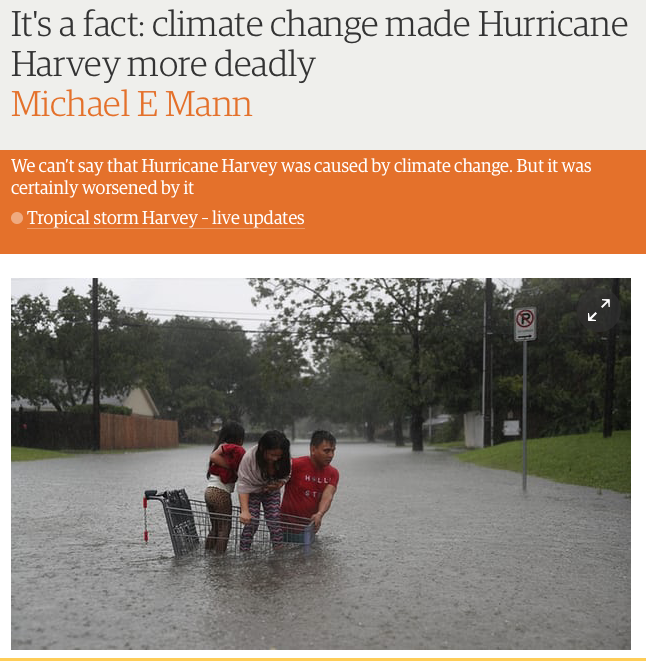
By Joe Bastardi
Dr. Mann at PSU has outdone himself. Back when New England had their famed February with snow and cold, he made the claim a warm eddy some 350 miles ESE of New England was enhancing water vapor and leading to extra snow. But:
- If he plotted trajectories from the storms he would see that the air from that source could not get back over New England since the mean flow would lead to enhanced snows in the Canadian Maritimes.
- Convective feedback from such warm eddies would act to PULL STORMS OUT TO SEA.
- The mean water vapor surface to 700 mb was BELOW NORMAL in New England in Feb 2015. The extra snow was high ratio snow with great crystal growth soundings because of the cold!
This is why climatologists should be forced to forecast for a year, so they can get an appreciation of what the weather does, not what they think it does based on their “research.”
But he may have outdone himself here.
I was emailed this quote, supposedly from him. It’s making the rounds in the skeptic community. It was in the Guardian
The stalling is due to very weak prevailing winds, which are failing to steer the storm off to sea, allowing it to spin around and wobble back and forth. This pattern, in turn, is associated with a greatly expanded subtropical high pressure system over much of the US at the moment, with the jet stream pushed well to the north. This pattern of subtropical expansion is predicted in model simulations of human-caused climate change.
He unwittingly describes THE EXACT OPPOSITE EFFECT to what is going on.
He could not have even looked at the 5 day means! There was no expansive subtropical high. Quite the contrary there was a well forecast MJO phase 2, with a major cool trough in the 5 day means trapping the hurricane. Out to sea? In August? In Texas? When does anyone see that? They move northwest or west through the state. BECAUSE NORMALLY THERE IS NOT A MAJOR TROUGH THAT FAR SOUTH TO STOP THE STORM! When has anyone given the coast of Texas seen a storm move “out to sea” what does it turn around and head back southeast? Look at the 500 mb means and 5k temps, This is what is a ridge? There is a major ridge in the west like we see when there are a lot of storms. It’s warm in the west cool in the east, but there is no subtropical ridge trapping this storm. It’s caught in trough.
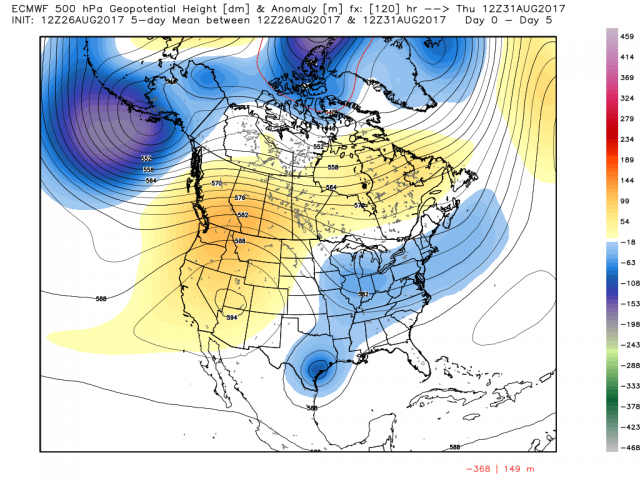
That is the five-day mean.
Here are the temps at 5K.
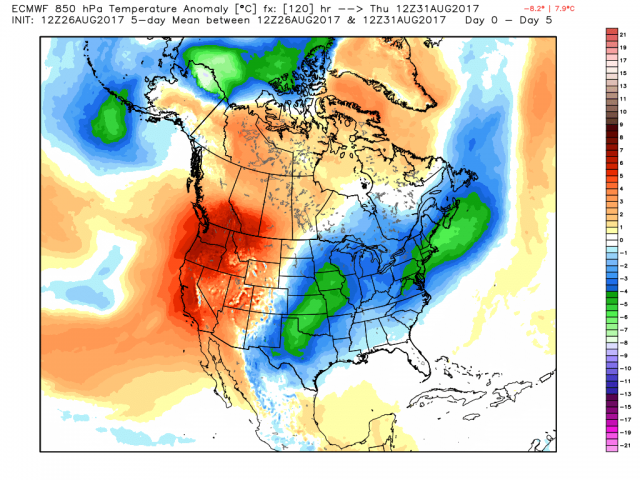
Which looks a lot like the phase 2 MJO I have been drooling about for over a week to set all this up.
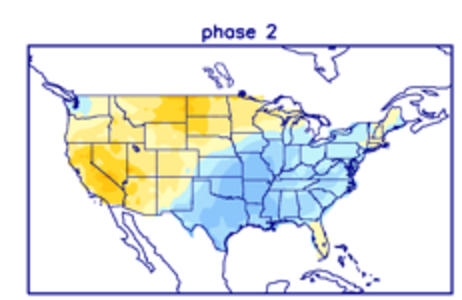
And it lights up the tropics.
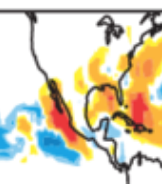
Here is the other little ditty he is blissfully unaware of. If it was just caught in a subtropical ridge, it would HAVE NO BAROCLINIC FORCING which enhanced the rain. The cooling from the trough while the storm was stalled and STILL bringing in warm moist air clearly helped amounts. Take a storm inland with a uniform temperature gradient as in an enhanced subtropical ridge, they die.
So what apparently he is describing is a ridge position enhanced that means the storms moves slow. DO YOU UNDERSTAND THAT THIS IS THE OPPOSITE? THIS IS A MAJOR TROUGH TOO FAR SOUTH. The same thing that caught Elena in 1985 except it was over the gulf.

It Caught Dennis in 1999.

But Dennis was over the water before he came back. You want really crazy? Look at Esther in 1961.

Major cool shots, not the kind of blocking ridge that you get occasionally like… let’s say Ginger in 1971 or Dora in 1964. Both storms that had major ridges to the north, which do happen sometimes steering them in. But amplitude happens. It always has and always will.
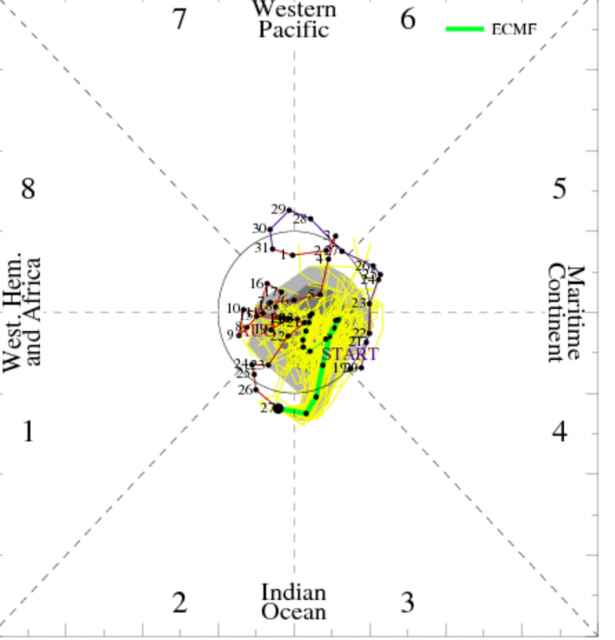
I usually do not get involved with the climatariat. But I set this pattern up from Spring. As soon as the cool started coming in July I said here we go. This phase 2 had me chomping at the bit (still does). So when I got emailed this tonight, I had to comment.
The gentler side of me understands he could not have looked at the major cold trough in the means when he accused the expansion of the subtropical ridge as the cause. The gentler side of me understands that he did not think about the implication of a storm trapped over land in a mainly barotropic atmosphere vs one where baroclinic processes are also going on (e.g., heavy rains on troughward side of recurving hurricanes) The gentle side would like to say, brother you should forecast for a year where something is on the line so you can understand what the heck you are saying.
That would be my suggestion, but that quote, given the actual reasons for what set this up and what occurred is about as opposite as you can get. And if someone wants to suggest the highly amplified pattern, which is what phase 2 in hurricane season does, where its hot in the west is the reason, then fine, quit talking about coast to coast heat cause it means there will be a whole lotta cooling going on.
Now if it’s me, I would be talking about the warmth of the oceans. (You see I know what they should be arguing.) And how in a phase 2 with all the cool in the US, that favors big storms near our coast. (You may see another next week, and whether named or not, this system tomorrow will have tropical storm conditions from NC to South Jersey). If the Atlantic was colder, it wouldn’t be as likely. But instead, to justify these nonsensical models, we get a quote when the actual set up reveals there is no abnormal subtropical ridge. IT’S OPPOSITE. THERE IS A BIG TROUGH OVER THE EAST. In fact Mann does not even understand that a stronger than normal SE US ridge generally means less impact on the US such as 2007. Our preseason idea showed how warmth may be distorting patterns so that it leads to less hits but this year we felt it would be different.Look at what has been going on, its been cool over the last month. Perhaps Mann is even unaware of that.
Let me tell you folks something, Harvey is horrible. For that area of Texas the rain is unprecented. Other areas have had it. But its not climate change, unless climate change means cooler than normal temps across much of the United states in one of the best growing season summers we have seen since the summers of 2013-2015 — even last year.
But what is despicable is what I see coming out. If Dr. Mann was out on a limb before the season showing what he thought, or even earlier this week, that is one thing, But this is an example of what will be a relentless tirade of statements Say nothing, make no forecast you can actually be held accountable for, then come out after and grab headlines with stuff like this. And if he wants to debate me on what caused this storm to act the way it did, given what I have shown, I’m right here, bring your stalled subtropical ridge but you wil have to glo look over Afrida cause tis not over the US And if he wants to tell me that the expansion of the subtropical ridgen now means a trough that catches and stops a tropical cyclone and enhances baroclinic processes in warm tropical air, I would love to see that explanation, that below normal heights and temps are a sign the subtropical ridge is stornger than normal, at an AMS conference with just operational mets looking on. Would be worth the price of admission
Get ready for more of this. We had a high impact, major hit drought ending hurricane season specifically targeting the northwest gulf in our preseason forecast with all the reasons. It’s why this year was different from the past 12, where by the way, because of it warming more in the north than over the tropics may be leading to a reduction of storms. You can read the why before what, having nothing to do with climate change, here. It’s from MAY! The only thing I updated was the ace to a normal range in June and there have been no updates since.
This is really starting to get nuts. They sit and hide and only come out after the fact. Let’s see him you make a forecast for the season or even 5 days out when this was nothing. Fat chance. But its not going to stop and its only going to get worse. In 10 days or so, another major impact event could threaten the southeast. Why? because that is the pattern we are in and it was predictable and still is. Nothing to do with CO2 or an agenda.
Ref.: https://wattsupwiththat.com/2017/08/31/michael-manns-claims-that-harvey-was-caused-by-global-warming-are-destroyed-by-an-operational-meteorologist/
……………………………
Hurricane Harvey In Perspective
By Paul Homewood
Thankfully it’s stopped raining in Houston, so time for a round up on Storm Harvey.
Total rainfall from the storm peaked at 51.88 in at Cedar Bayou, just outside Houston.


http://www.wpc.ncep.noaa.gov/discussions/nfdscc1.html
This beat the previous record rainfall from a single storm over the contiguous US. The previous record was 48 in from Storm Amelia in 1978, also in Texas. However, most of that fell over just four days, from Aug 2nd to 5th.
Rainfall from Harvey was less intensive, as it was spread over five days.
Neither event was close in intensity to Storm Claudette, which dumped 43 in on Alvin, Texas in July 1979 in a single 24-hour period.
Texas Hurricane Trends
In 2010, David Roth of the NWS published his “Texas Hurricane History”, which gave this list of Texas landfalling cyclones:

Since 2010, there have been three tropical storms, Alex, Hermine and Bill, and no hurricanes (prior to Harvey of course).
The 1940s was by far the busiest decade.
Roth goes on to explain why the weaker tropical storms tend to carry the greatest flooding risk:
He also includes the full list of hurricanes:


Based on this list, and including Harvey, we can tabulate the number of major hurricanes by decade:

Clearly there is no trend towards more powerful hurricanes, and Harvey was the first Cat4 since Gilbert in 1988. (I have seen it incorrectly reported that Harvey was the most powerful Texas hurricane for “more than 50 years”).
Roth also has an account of one the worst Texas floods on record, San Antonio’s Great Flood of 1921:

The rainfall recorded over 18 hours in Williamson County was far greater than anything experienced around Houston during Harvey.
Jet Stream Behaviour
The usual suspects have attempted to claim that global warming has made Harvey more intense than it would have been otherwise, for instance Mann and Trenberth here.
However, comparison with earlier storms, such as San Antonio, Amelia (1978) and Claudette (1979) discredits such claims.
As we know, the only reason why so much rain fell on Houston was because Harvey was stuck between two high pressure systems for five days. So step forward Michael Mann to claim that this weather event was due to climate change!
“The kind of stalled weather pattern that is drenching Houston is precisely the sort of pattern we expect because of climate change,” climatologist Michael Mann explained in an email to ThinkProgress.
Earlier this year, Mann co-authored a study explaining how human-caused warming is changing our atmosphere’s circulation, including the jet stream, in a way that leads to “increase in persistent weather extremes” during the summer.
“I agree with Mike [Mann] that the weak steering currents over the south-central US coincident with Harvey are consistent with our expectations for a warmer world, which of course includes effects of a very warm Arctic,” Jennifer Francis, a climate scientist at Rutgers University, told ThinkProgress.
Francis is a leading expert on how global warming and the related Arctic amplificationaffect the jet stream and extreme weather. A study she co-authored that appeared in the Journal of Climate in June, concludes, “Over the central United States during summer, the weaker and wavier flow” of the jet stream favors “more intense summer weather.”
A 2012 study led by the National Oceanic and Atmospheric Administration (NOAA), and coauthored by Francis, concluded global warming was driving changes in extreme weather in North America. “Our research reveals a change in the summer Arctic wind pattern over the past six years,” lead author James Overland of NOAA explained at the time. “This shift demonstrates a physical connection between reduced Arctic sea ice in the summer, loss of Greenland ice, and potentially, weather in North American and Europe.”
“Enhanced warming of the Arctic affects the jet stream by slowing its west-to-east winds and by promoting larger north-south meanders in the flow,” NOAA said in a press release. “The researchers say that with more solar energy going into the Arctic Ocean because of lost ice, there is reason to expect more extreme weather events, such as heavy snowfall, heat waves, and flooding in North America and Europe but these will vary in location, intensity, and timescales.”
Only one problem with Mickey Mann’s theory!
HH Lamb found exactly the same phenomenon back in the 1960s and 70s, when the Arctic was getting much colder and the sea ice was expanding. In 1982, he wrote:
Such worldwide surveys as have been attempted seem to confirm the increase of variability of temperature and rainfall [since 1950].’’
In Europe, there is a curious change in the pattern of variability: from some time between 1940 and 1960 onwards, the occurrence of extreme seasons – both as regards temperature and rainfall has notably increased.
These variations, perhaps more than any underlying trend to a warmer or colder climate, create difficulties for the planning age in which we live. They may be associated with the increased meridionality of the general wind circulation, the greater frequency of blocking, of stationary high and low pressure systems, giving prolonged northerly winds in one longitude and southerly winds in another longitude sector in middle latitudes.
Over both hemispheres there has been more blocking in these years… The most remarkable feature seems to be the an intensification of the cyclonic activity in high latitudes near 70-90N, all around the northern polar region. And this presumably has to do with the almost equally remarkable cooling of the Arctic since the 1950’s, which has meant an increase in the thermal gradient between high and middle latitudes.
https://notalotofpeopleknowthat.wordpress.com/2017/04/16/micky-manns-meandering-jetstream/
And he was not the only one. CC Wallen of the WMO wrote:
The principal weather change likely to accompany the cooling trend is increased variability-alternating extremes of temperature and precipitation in any given area-which would almost certainly lower average crop yields.
During cooler climatic periods the high-altitude winds are broken up into irregular cells by weaker and more plentiful pressure centers, causing formation of a “meridional circulation” pattern. These small, weak cells may stagnate over vast areas for many months, bringing unseasonably cold weather on one side and unseasonably warm weather on the other. Droughts and floods become more frequent and may alternate season to season, as they did last year in India. Thus, while the hemisphere as a whole is cooler, individual areas may alternately break temperature and precipitation records at both extremes.
https://notalotofpeopleknowthat.wordpress.com/2017/04/16/micky-manns-meandering-jetstream/
In other words, these proper scientists found the exact opposite of what Mann and Francis are claiming now.





